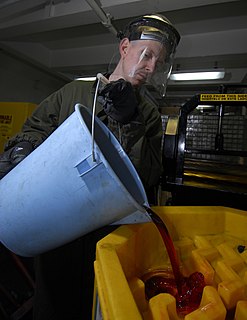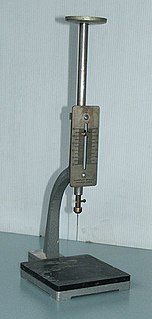
Motor oil, engine oil, or engine lubricant is any of various substances comprising base oils enhanced with additives, particularly antiwear additive plus detergents, dispersants and, for multi-grade oils viscosity index improvers. Motor oil is used for lubrication of internal combustion engines. The main function of motor oil is to reduce friction and wear on moving parts and to clean the engine from sludge and varnish (detergents). It also neutralizes acids that originate from fuel and from oxidation of the lubricant (detergents), improves sealing of piston rings, and cools the engine by carrying heat away from moving parts.

A hydraulic fluid or hydraulic liquid is the medium by which power is transferred in hydraulic machinery. Common hydraulic fluids are based on mineral oil or water. Examples of equipment that might use hydraulic fluids are excavators and backhoes, hydraulic brakes, power steering systems, transmissions, garbage trucks, aircraft flight control systems, lifts, and industrial machinery.

The flash point of a volatile material is the lowest temperature at which vapours of the material will ignite, when given an ignition source.
The National Lubricating Grease Institute is an international trade association that serves the grease and gear lubricant industry. It exists to promote research and development of lubrication technology. It also publishes industry standards for greases.
The NLGI consistency number expresses a measure of the relative hardness of a grease used for lubrication, as specified by the standard classification of lubricating grease established by the National Lubricating Grease Institute (NLGI). Reproduced in standards ASTM D4950(“standard classification and specification of automotive service greases”) and SAE J310(“automotive lubricating greases”), NLGI's classification is widely used. The NLGI consistency number is also a component of the code specified in standard ISO 6743-9“lubricants, industrial oils and related products — classification — part 9: family X (greases)”.
Timken OK Load is a standardized measurement that indicates the possible performance of extreme pressure (EP) additives in a lubricating grease or oil. The units of measurement are pounds-force or kilograms-force. This measurement is performed using a special test machine and standard block and ring test specimens.
The American Petroleum Institute gravity, or API gravity, is a measure of how heavy or light a petroleum liquid is compared to water: if its API gravity is greater than 10, it is lighter and floats on water; if less than 10, it is heavier and sinks.

Vicat softening temperature or Vicat hardness is the determination of the softening point for materials that have no definite melting point, such as plastics. It is taken as the temperature at which the specimen is penetrated to a depth of 1 mm by a flat-ended needle with a 1 mm2 circular or square cross-section. For the Vicat A test, a load of 10 N is used. For the Vicat B test, the load is 50 N.
Silicone grease, sometimes called dielectric grease, is a waterproof grease made by combining a silicone oil with a thickener. Most commonly, the silicone oil is polydimethylsiloxane (PDMS) and the thickener is amorphous fumed silica. Using this formulation, silicone grease is a translucent white viscous paste, with exact properties dependent on the type and proportion of the components. More specialized silicone greases are made from fluorinated silicones or, for low temperature applications, PDMS containing some phenyl substituents in place of methyl groups. Other thickeners may be used, including stearates and powdered polytetrafluorethylene (PTFE).
In the petroleum industry, cloud point refers to the temperature below which wax in diesel or biowax in biodiesels forms a cloudy appearance. The presence of solidified waxes thickens the oil and clogs fuel filters and injectors in engines. The wax also accumulates on cold surfaces and forms an emulsion with water. Therefore, cloud point indicates the tendency of the oil to plug filters or small orifices at cold operating temperatures.
The pour point of a liquid is the temperature below which the liquid loses its flow characteristics. In crude oil a high pour point is generally associated with a high paraffin content, typically found in crude deriving from a larger proportion of plant material. That type of crude oil is mainly derived from a kerogen Type III.
Lithium soap, often loosely referred to as "lithium grease" or "white lithium", is a soap that is a lithium derivative. Lithium soaps are primarily used as components of certain lubricant greases.
The Noack volatility test, named after Kurt Noack, determines the evaporation loss of lubricants in high-temperature service. This test is standardized as ASTM D5800.

The Pensky–Martens closed-cup flash-point test is a test for the determination of the flash point of flammable liquids. It is standardized as ASTM D93, EN ISO 2719 and IP 34 The United States Environmental Protection Agency (EPA) has also published Method 1010A: Test Methods for Flash Point by Pensky-Martens Closed Cup Tester, part of Test Methods for Evaluating Solid Waste, Physical/Chemical Methods, which references the ASTM standard series D93. The Pensky-Martens test is a closed-cup method as opposed to the Cleveland open-cup method.
Reid vapor pressure (RVP) is a common measure of the volatility of gasoline and other petroleum products. It is defined as the absolute vapor pressure exerted by the vapor of the liquid and any dissolved gases/moisture at 37.8 °C (100 °F) as determined by the test method ASTM-D-323, which was first developed in 1930 and has been revised several times. The test method measures the vapor pressure of gasoline, volatile crude oil, jet fuels, naphtha, and other volatile petroleum products but is not applicable for liquefied petroleum gases. ASTM D323-15a requires that the sample be chilled to 0-1 degrees Celsius and then poured into the apparatus; for any material that solidifies at this temperature, this step cannot be performed. RVP is commonly reported in kilopascals or pounds per square inch and represents volatization at atmospheric pressure because ASTM-D-323 measures the gauge pressure of the sample in a non-evacuated chamber.

Koehler Instrument, or Koehler, is a US company which provides petroleum and petrochemical testing equipment and technical support services to testing laboratories worldwide. The company’s corporate headquarters is in Holtsville, NY and the manufacturing headquarters is in Bohemia, NY.

Package testing or packaging testing involves the measurement of a characteristic or property involved with packaging. This includes packaging materials, packaging components, primary packages, shipping containers, and unit loads, as well as the associated processes.
Total Base Number (TBN) is a measurement of basicity that is expressed in terms of the equivalent number of milligrams of potassium hydroxide per gram of oil sample. TBN is an important measurement in petroleum products, and the value varies depending on its application. TBN generally ranges from 6–80 mg KOH/g in modern lubricants, 7–10 mg KOH/g for general internal combustion engine use and 10–15 mg KOH/g for diesel engine operations. TBN is typically higher for marine grade lubricants, approximately 15-80 mg KOH/g, as the higher TBN values are designed to increase the operating period under harsh operating conditions, before the lubricant requires replacement.











